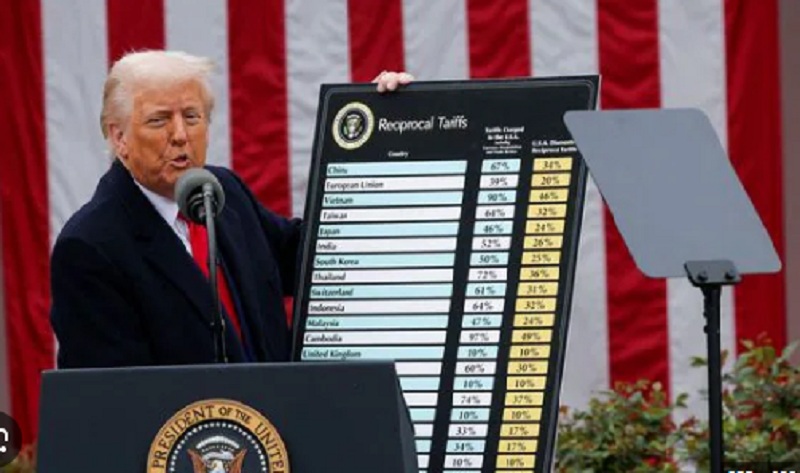By Anuradha Chenoy
US President Donald Trump has initiated a global trade war — politely called “reciprocal tariffs”.
Tariffs are taxes that countries levy on imported goods which make them more expensive and unaffordable with the intent of encouraging domestic manufacturing.
At the same time, the global economy prospers if some goods are imported from other countries where they are cheaper to produce, and satisfy domestic consumers.
In return, the importing country can produce goods or technologies that serve the exporter countries. This becomes a cycle of trade flows and value chains based on comparative or even absolute advantage.
President Trump, who won a second term on the slogan ‘Make America Great Again’ (MAGA), has two underlying assumptions behind his economic un-planning.
One, that he can literally kickstart American manufacturing by putting high tariffs on basic goods imported from all countries into the US. Two, he will use the instrument of reciprocal tariffs; i.e., any country that puts tariffs on US goods will be subject to tariffs in return, whether those goods imported by the US are important for the US consumer or not.
This, he believes, will force countries that import US goods to lower the taxes on them, so they are more affordable in the host country.
By levying tariffs Trump is punishing the US consumer for past US economic policies where manufacturing was outsourced to countries with cheap labour and easily available raw materials and then imported by the US.
Very often US companies themselves outsourced such manufacturing and made financial gains. Trump is also punishing other countries especially from the Global South like India, Vietnam, Indonesia, China etc. al., where cheap labour allows them to make goods at much cheaper rates than the US.
This has benefited the US consumer all these years.
India, along with other countries, is also a target, as Trump has imposed a 27 percent tariff on Indian exports into the US.
The US is a major destination for Indian exports comprising about 18 percent of India’s outbound trade. The World Trade Organization, of which the US is still a part, says that imports from developing countries should see fewer tariffs to encourage equitable growth, but Trump does not care for the multilateral rules-based order and he has little interest in the growth of countries like India.
Trump’s policy of reciprocal tariffs means that India will have to lower the tariffs it imposes on goods imported from the US. These tariffs were imposed by India to protect its own nascent industries.
Trump has specifically pointed to these Indian tariffs as being unfair to the US. By lowering tariffs on US imports under pressure, India could see more American goods in its market, even at the cost of Indian-made goods.
The Indian Government believes that lower tariffs on US Electric Vehicles (EVs) could be a good thing and seems happy to comply. But will the Indian EV manufacturers be happy?
Moreover, will the Indian luxury car buyer who demands Toyota SUVs, BMWs, etc. now switch to Fords and Chevrolets? And will the Indian drinking class switch from the Glens and Scotches to American bourbons?
America’s tariff war will be a setback to developing economies like India who may be forced to undo their protective tariff barriers to let in American goods and initiate a change in their consumer patterns. Even if this pleases the US, it takes away from the strategic and economic autonomy of India.
Trump’s unilateral tariffs with global designs are unlikely to fulfill his mercantilist desires.
International trade economist Professor Sunanda Sen believes that these reciprocal tariffs can bring in global recession, with multiple nations (including the US) in the grip of a contracting spiral of their respective GDPs.
Tariffs are an old 19th Century method of protecting economies. However, post-globalisation where value chains have been internationalised, Trump’s tariffs will be highly disruptive with unintended consequences that are difficult to predict.
What should countries like India do to avert being drawn into a US-led global recession?
India has been opening its economy to the US and Indian businesses have struggled and managed to develop comfortable supply chains with the US. They will now have to diversify. The government needs to help small and medium enterprises and manufacturing exporters diversify to other countries and markets.
The US’s imports constitute about 15 percent of all global markets. This means that other economies receive 85 percent of the global exports. If carefully planned, the US induced tariff crisis can be averted. India has also diversified its key import sectors. India is welcoming defense imports from the US with lucrative profits for US defense industries.
Further, Trump has pushed India to buying more oil and hydrocarbons from the US and India is doing that. India can leverage this for other concessions.
India has been happily appeasing the US, but as these punitive tariffs show, the US wants more. The belief that by bandwagoning with the US India could have avoided punitive reciprocal tariffs has turned out to be false. It will not lead to Indian growth or economic stability.
Therefore, India must work at making India great as opposed to bending over backwards for the MAGA programme.
ALSO READ: India’s growing misinformation crisis a threat to democracy
The Indian government has set up a control room to monitor the tariff issue. India has enough economists who can show the way so that India does not subordinate its core interests and growth trajectory to US interests.
Economic autonomy is key to strategic autonomy, multipolarity and better development for the Indian people.
Anuradha Chenoy is Adjunct Professor, O.P. Jindal Global University at Sonipat, India.
Originally published under Creative Commons by 360info™.















